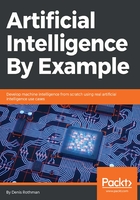
What this book covers
Chapter 1, Become an Adaptive Thinker, covers reinforcement learning through the Bellman equation based on the Markov Decision Process (MDP). A case study describes how to solve a delivery route problem with a human driver and a self-driving vehicle.
Chapter 2, Think like a Machine, demonstrates neural networks starting with the McCulloch-Pitts neuron. The case study describes how to use a neural network to build the reward matrix used by the Bellman equation in a warehouse environment.
Chapter 3, Apply Machine Thinking to a Human Problem, shows how machine evaluation capacities have exceeded human decision-making. The case study describes a chess position and how to apply the results of an AI program to decision-making priorities.
Chapter 4, Become an Unconventional Innovator, is about building a feedforward neural network (FNN) from scratch to solve the XOR linear separability problem. The business case describes how to group orders for a factory.
Chapter 5, Manage the Power of Machine Learning and Deep Learning, uses TensorFlow and TensorBoard to build an FNN and present it in meetings.
Chapter 6, Don't Get Lost in Techniques – Focus on Optimizing Your Solutions, covers a K-means clustering program with Lloyd's algorithm and how to apply to the optimization of automatic guided vehicles in a warehouse.
Chapter 7, When and How to Use Artificial Intelligence, shows cloud platform machine learning solutions. We use Amazon Web Services SageMaker to solve a K-means clustering problem. The business case describes how a corporation can analyze phone call durations worldwide.
Chapter 8, Revolutions Designed for Some Corporations and Disruptive Innovations for Small to Large Companies, explains the difference between a revolutionary innovation and a disruptive innovation. Google Translate will be described and enhanced with an innovative opensource add-on.
Chapter 9, Getting Your Neurons to Work, describes convolutional neural networks (CNN) in detail: kernels, shapes, activation functions, pooling, flattening, and dense layers. The case study illustrates the use of a CNN in a food processing company.
Chapter 10, Applying Biomimicking to Artificial Intelligence, describes the difference between neuroscience models and deep learning solutions when representing human thinking. A TensorFlow MNIST classifier is explained component by component and displayed in detail in TensorBoard. We cover images, accuracy, cross-entropy, weights, histograms, and graphs.
Chapter 11, Conceptual Representation Learning, explains Conceptual Representation Learning (CRL), an innovative way to solve production flows with a CNN transformed into a CRL Meta-model. The case study shows how to use a CRLMM for transfer and domain learning, extending the model to scheduling and self-driving cars.
Chapter 12, Automated Planning and Scheduling, combines CNNs with MDPs to build a DQN solution for automatic planning and scheduling with an optimizer. The case study is the optimization of the load of sewing stations in an apparel system, such as Amazon's production lines.
Chapter 13, AI and the Internet of Things (IoT), covers Support Vector Machines (SVMs) assembled with a CNN. The case study shows how self-driving cars can find an available parking space automatically.
Chapter 14, Optimizing Blockchains with AI, is about mining blockchains and describes how blockchains function. We use Naive Bayes to optimize the blocks of a Supply Chain Management (SCM) blockchain by predicting transactions to anticipate storage levels.
Chapter 15, Cognitive NLP Chatbots, shows how to implement IBM Watson's chatbot with intents, entities, and a dialog flow. We add scripts to customize the dialogs, add sentiment analysis to give a human touch to the system, and use conceptual representation learning meta-models (CRLMMs) to enhance the dialogs.
Chapter 16, Improve the Emotional Intelligence Deficiencies of Chatbots, shows how to turn a chatbot into a machine that has empathy by using a variety of algorithms at the same time to build a complex dialog. We cover Restricted Boltzmann Machines (RBMs), CRLMM, RNN, word to vector (word2Vec) embedding, and principal component analysis (PCA). A Python program illustrates an empathetic dialog between a machine and a user.
Chapter 17, Quantum Computers That Think, describes how a quantum computer works, with qubits, superposition, and entanglement. We learn how to create a quantum program (score). A case study applies quantum computing to the building of MindX, a thinking machine. The chapter comes with programs and a video.
Appendix, Answers to the Questions, contains answers to the questions listed at the end of the chapters.